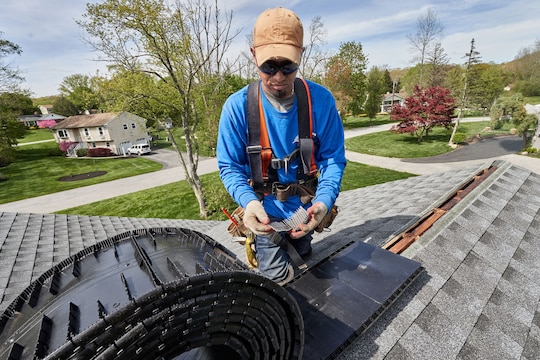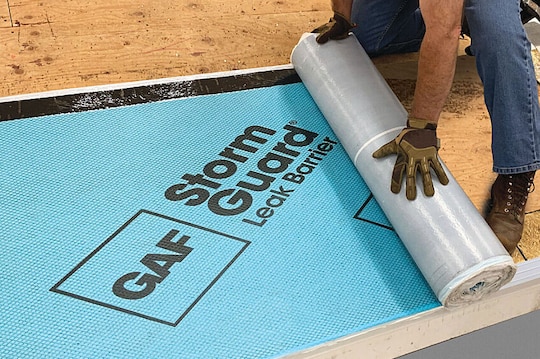
Do leaks or roof damage have you wondering if it's time for a roof repair or replacement? You may need to call on a roofing contractor. So, don't panic—but don't delay, either. The roof is your home's first line of defense against the elements, and you want it to stay in prime condition.
Homeownership can introduce pressing roofing questions. Here's a guide to help you choose your next steps.
How Do You Know If You Need a Roof Replacement?
Reputable roofers typically provide free estimates to help you assess the scope of your roofing project. Remember, climbing onto your roof can be dangerous and may compound existing roof damage. Instead, walk around the exterior of your home or assess the interior. Be sure to call a pro if you notice any of these common signs of damage:
Outside the Home:
- Visible roof debris or damage, such as a tree limb or hail damage
- A sagging roof
- Cracked, curling, or missing shingles
- Peeling exterior paint
Inside the Home:
- Outside light shining into the attic, which could indicate a breach in the roof
- Visible damage to the roof rafters and joists
- Water stains or peeling paint on the ceiling or walls
- Moisture and mildew in the attic
In some cases, a roof repair may resolve your problems. In others, a roof replacement will provide a more comprehensive fix. What's important to remember is that after you've consulted with a professional and made a decision, be sure to act on it—quick action can prevent larger, more expensive problems down the line.
What Are the Advantages of a Roof Replacement?
A new roof is more than a new layer of shingles. It's a comprehensive roofing system that's built to last. During an installation, it is recommended that trained contractors completely remove the existing roof and create a weathertight series of layers from the decking up. A trusted pro will likely recommend installing crucial components like drip edge, flashing, underlayment and leak barrier to help lock out future leaks.
New roofs can also qualify for enhanced warranties. One option is the GAF Roofing System Limited Warranty * available when three or more qualifying GAF accessory products are installed with any GAF Lifetime* shingle. Another advantage of a new roof is the opportunity to upgrade your curb appeal. You can choose exactly the color or style—such as architectural shingles—that you've always wanted for your home.
What Happens If You Don't Replace Your Roof?
When you ignore initial signs of damage, problems only get worse. One example is how broken shingles can lead to leaks, which can then lead to mold. Eventually, you run the risk of water damage and mold deteriorating your home's structural integrity. Another consequence of waiting too long is that you might lose out on insurance or warranty coverage that you would have been eligible for had you acted immediately. A necessary roof repair or replacement is one home improvement project that should always take priority.
When Should You Replace Your Roof?
Each roof is impacted differently by factors such as regional climate, installation practices, and roofing materials. Because these factors are unique for every home, it is always good to consult with a professional at the first sign of trouble in order to determine if you need a roof repair or replacement.
Quality roofing materials, like the Timberline® HDZ™ Shingle, will offer homeowners a Lifetime* limited warranty and can be a major component of building a roof that lasts. You may also be eligible for an enhanced warranty when a certified contractor by GAF performs your installation.
Does Homeowners Insurance Cover Roofing Costs?
Homeowners insurance may cover some or all of the cost to repair or replace your roof if the damage results from an accident or unexpected storm. For example, many policies cover roof damage from hail, but there may be exceptions based on your policy or your location. That's why it's so important to understand your policy and request any additional coverage you think you may need well before damages actually occur. This handy storm guide helps lays out how to work with a contractor and your insurance agency after a storm causes roof damage.
The cost to install a new roof will vary based on a host of factors, including local labor costs, the time of year, materials, and the size of your roof. Your roof pitch may also impact cost—steep roofs can require additional safety measures to keep workers safe. As you gather quotes, it's helpful to remember that roofers typically measure your roof in squares. One square equals 100 square feet. In other words, your 20-square project will cover a 2,000 square foot roof. The quote your roofer gives you for a roof replacement or repair may come either in squares or by the square foot.
In the case that your insurance does not cover (or only partially covers) roofing costs, financing a roof replacement may be a wise investment. Depending on the state you live in, financing may also cover the insurance deductible. Keep in mind that the average cost for a roof repair or replacement will typically be lower the sooner you identify and resolve the problem.
For trusted guidance when you need roofing help, contact your local contractor certified by GAF.**
*The word "Lifetime" refers to the length of coverage provided by the GAF Shingle & Accessory Ltd. Warranty or GAF Roofing System Limited Warranty, and means as long as the original individual owner(s) of a single-family detached residence [or the second owner(s) in certain circumstances] owns the property where the shingles and accessories are installed. For owners/structures not meeting the above criteria, Lifetime coverage is not applicable. Lifetime ltd. warranty on accessories requires the use of at least three qualifying GAF accessories and the use of Lifetime Shingles. See GAF Shingle & Accessory Limited Warranty and GAF Roofing System Limited Warranty for complete coverage and restrictions. Visit gaf.com/lrs for a complete list of qualifying products.
**Contractors enrolled in GAF certification programs are not employees or agents of GAF, and GAF does not control or otherwise supervise these independent businesses. Contractors may receive benefits, such as loyalty rewards points and discounts on marketing tools from GAF for participating in the program and offering GAF enhanced warranties, which require the use of a minimum amount of GAF products.




